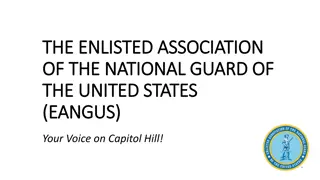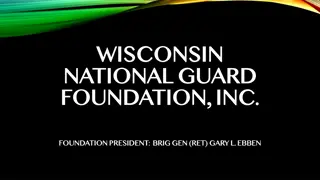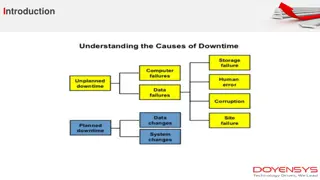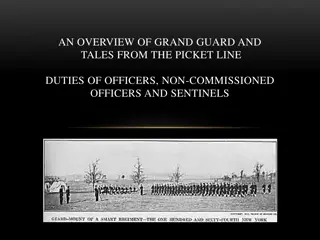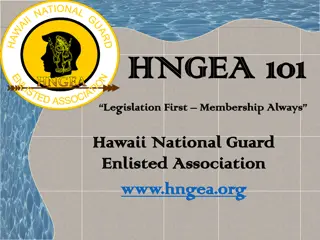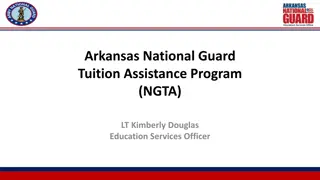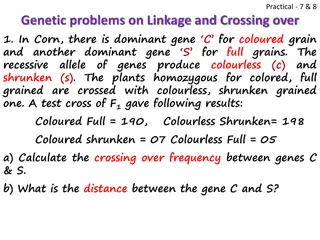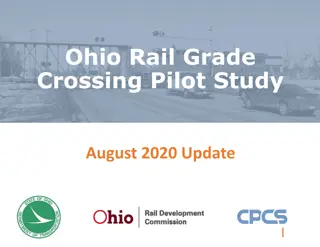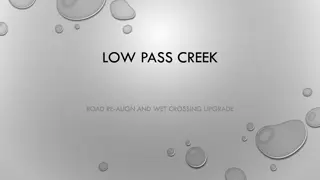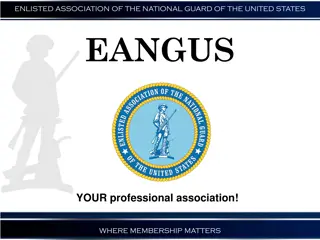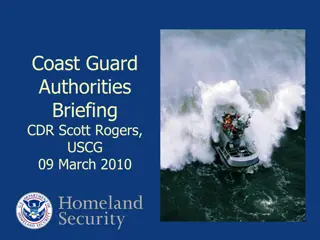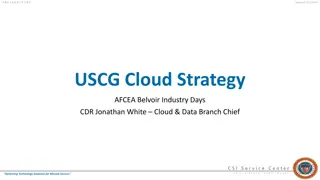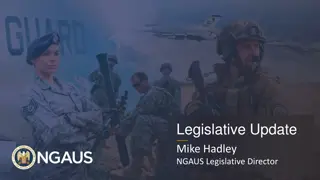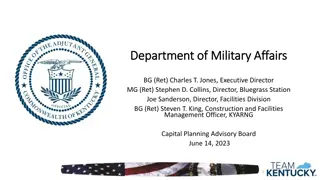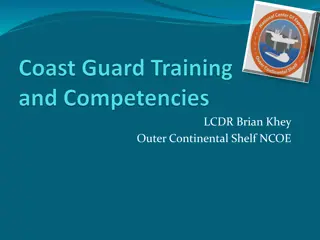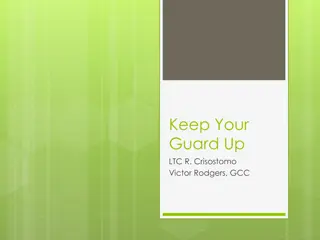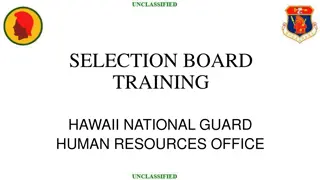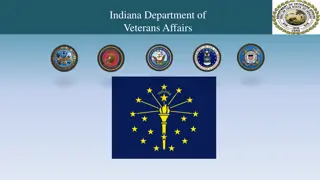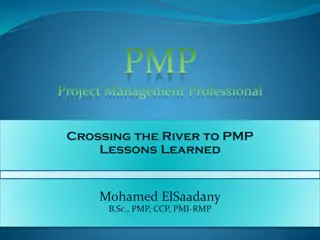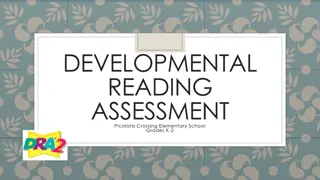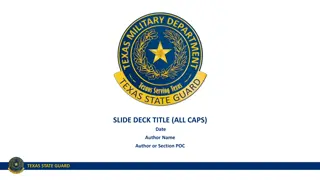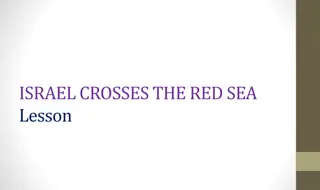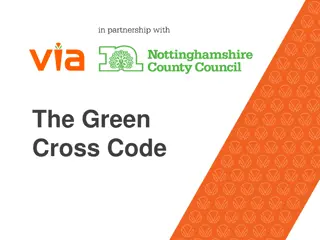School Crossing Guard Training Course
The School Crossing Guard Training Course! This course aims to provide standardized training to new and seasoned crossing guards, helping them understand their roles, learn relevant laws, practice proper crossing techniques, and foster safe environments.
Download Presentation

Please find below an Image/Link to download the presentation.
The content on the website is provided AS IS for your information and personal use only. It may not be sold, licensed, or shared on other websites without obtaining consent from the author. Download presentation by click this link. If you encounter any issues during the download, it is possible that the publisher has removed the file from their server.
E N D
Presentation Transcript
Welcome! School Crossing Guard Training Course
School Crossing Guard Training Course The School Crossing Guard Training Course is made up of four (4) components: School Crossing Guard Training Presentation (this presentation) Testing Practical Training Field Assessment 2
School Crossing Guard Training Course The goal of this course is to provide standardized training to newly employed school crossing guards as well as seasoned school crossing guards to help them understand their roles and responsibilities, learn about relevant laws and traffic regulations, practice proper crossing techniques, and foster safe environments. 3
Learning Objectives Describe at least one reason why school crossing guards are needed at a crossing location. Demonstrate the proper crossing procedure. 4
Why School Crossing Guards? School crossing guards play an integral role in fostering a safe and comfortable environment for students walking and bicycling to and from school. School crossing guards can help create gaps in traffic on busy roads, remind drivers of the presence of people walking, help instill safe walking skills in students and their families, and indicate when people driving should yield. 5
Why School Crossing Guards? Training is an essential step to help ensure that school crossing guards are performing their duties properly and safely. This course provides consistent guidance to assist in training school crossing guards. The course aligns with Manual on Uniform Traffic Control Devices (also known as the MUTCD) and Colorado state law. 6
Why School Crossing Guards? In a 2012 University of California, San Francisco study, parents/caregivers ranked safety of intersections and crossings as the number one concern affecting their decision to allow their students to walk or bicycle to school. In the same study, parents/caregivers ranked school crossing guards as the number two reason why they would let their student walk or bicycle to school. Walking or bicycling with an adult was number one. National Center for SRTS data continue to affirm these parent/caregiver concerns. 7
School Crossing Guard Sponsors A School Crossing Guard Sponsor refers to any city, county, school, school district, or police department that is the fiscal and/or implementing agency responsible for school crossing guard employment and training. 8
School Crossing Guard Sponsors School crossing guard sponsors are responsible for: 1. Obtaining a school crossing guard trainer and training school crossing guards 2. Hiring and managing school crossing guards 3. Providing uniforms and equipment to school crossing guards 4. Identifying where school crossing guards are needed 5. Addressing liability and risk management 9
School Community School crossing guards are representatives of the school community, tasked with helping to create a safe environment for students and their families. As such, it is important that they conduct themselves in a manner befitting a school representative and treat all students, families, and staff with kindness. 10
Getting Ready for the Job Attendance Protocol School crossing guards should: Notify their supervisor of a planned absence at least 24 hours in advance, so that a substitute can be found. Notify the supervisor as soon as possible if illness or unexpected circumstance prevents their timely appearance, so that a substitute can be found. Be at their station on time and properly attired. 12
Getting Ready for the Job Personal Vehicle Parking School crossing guards should only park their vehicles in an allowed location (e.g., not on a sidewalk, not in any location where signs prohibit parking at the time). School crossing guards vehicles should not block the view of approaching vehicles. 13
Getting Ready for the Job Uniform and Equipment While on the job, school crossing guards are required to wear: Retroreflective safety apparel such as a vest or jacket. The outermost layer of the school crossing guard s clothes must be retroreflective. STOP paddle. The paddle must be at least 18 inches in size and have the word message STOP on both sides. The paddle must also be retroreflective. It can also be illuminated for use when dark. Optional Reflective Safety Hat. If a reflective safety hat is worn, it should be retroreflective like the retroreflective safety vest or outerwear. Optional Whistle. A whistle can be used as a warning device to alert a motorist who is unresponsive to the display of the STOP paddle. If a whistle is used, it should remain in the school crossing guard s mouth as they step into the crosswalk to conduct crossing procedures. 14
Getting Ready for the Job Standing While on Duty The visible presence of an alert school crossing guard can help to discourage unsafe behavior. School crossing guards should not sit while on duty. Sitting down reduces an approaching driver s view of the school crossing guard or might suggest to drivers or arriving students that the school crossing guard is not on duty. School crossing guards need to be ready to react quickly in case of an unexpected event. 15
Getting Ready for the Job Distractions and Unrelated Activities While on duty or in uniform, School crossing guards should not eat, smoke products of any kind, consume beverages (other than water), or patronize liquor establishments. School crossing guards should not use a radio (other than a two-way radio for official communication), computer, mobile devices, headphones, portable audio players, or read (e.g., books, magazines, newspapers). A mobile communication device may be used only in an emergency and never while crossing students. 16
Getting Ready for the Job Interaction with Students School crossing guards should not physically touch students. Students should never be put into a school crossing guard s vehicle. School crossing guards should never give gifts to students. 17
Getting Ready for the Job First Aid School crossing guard sponsors are strongly encouraged to provide first aid and cardiopulmonary resuscitation (CPR) training to all school crossing guards. School crossing guards who have not received proper training should not provide first aid or CPR while on duty. All school crossing guards should be prepared to take reasonable action to help an injured student or contact emergency responders. 18
Getting Ready for the Job Emergencies School crossing guards should be briefed on emergency responses that have been adopted by the school crossing guard sponsor or school, especially if circumstances require a special procedure for school crossing guards. Notify your supervisor if you have not received this information. [Insert paragraph or slide showing school crossing guard sponsor s emergency response plan, if you have one] 19
Getting Ready for the Job Incident Reporting School crossing guards should be familiar with the type of information necessary to complete an incident report (e.g., time, date, location, names of those involved, description of incident). Incident reports are typically used to report a crash or infraction that can endanger the lives of pedestrians. 20
Getting Ready for the Job Incident Reporting (Continued) School crossing guards are advised to carry a notebook and pen to write down a description of involved vehicles and/or individuals. School crossing guards are encouraged to be on the lookout for any potential problems or areas of concern while on duty and be prepared to report them to the appropriate individuals or supervisors. 21
On the Job Remember, a school crossing guard s job is to help create gaps in traffic on busy roads, remind drivers of the presence of people walking, help instill safe walking skills in students and their families, and indicate when people driving should yield. Essentially, a school crossing guard becomes a STOP sign in the middle of a crosswalk. 23
On the Job - Crossing Procedure at Unsignalized Crosswalks Unsignalized crosswalks are the most common crosswalks that need a school crossing guard. 24
On the Job - Crossing Procedure at Unsignalized Crosswalks (1) To begin the crossing procedure, first gather students. Wait with students on the edge of the roadway outside of the crosswalk as they gather to cross. Tell students you will tell them when they may cross. 25
On the Job - Crossing Procedure at Unsignalized Crosswalks (2) Next, find a gap in traffic. Look all ways for approaching vehicles. Look left, right, front, and behind for approaching vehicles. Find the gap in traffic. A gap in traffic means there are no vehicles approaching the crosswalk or that there are no vehicles within 100 to 200 feet (about half a football field or one soccer field) from the crosswalk. You will practice finding gaps in traffic during Practical Training. 26
On the Job - Crossing Procedure at Unsignalized Crosswalks (3) Then, enter the crosswalk. Raise the STOP paddle and hold your other hand with an upraised palm as you walk into the crosswalk. The STOP paddle should lead you as you enter the crosswalk. Hold the STOP paddle shoulder-high so that one side is displayed to vehicles approaching the crosswalk on the near side of the street and the other is displayed to vehicles approaching the crosswalk on the far side of the street. Your body should not block either view of the STOP paddle. The two faces of the STOP paddle should remain continuously visible to vehicles approaching on the respective sides. 27
On the Job - Crossing Procedure at Unsignalized Crosswalks (4) Then, take your position. Stop in the middle of the crosswalk. Stand at the edge of the crosswalk, either at the front or back, making space so that students can clearly pass without running into you. The STOP paddle should be kept raised while in the roadway. A school crossing guard should not switch the STOP paddle from one hand to the other or wave it about while in the roadway. 28
On the Job - Crossing Procedure at Unsignalized Crosswalks (5) Next, signal students. When you know there are no vehicles coming, or that there is enough time for drivers to yield, look at the students and loudly say You may cross. DO NOT move your hands when signaling students to cross. PLEASE NOTE: Students and others with special needs may need more time to cross. 29
On the Job - Crossing Procedure at Unsignalized Crosswalks (6) Signaling drivers. While in the crosswalk, a school crossing guard should never make any hand or head movement that might be interpreted by a driver as a signal to proceed. A school crossing guard should maintain eye contact directly with approaching drivers. 30
On the Job - Crossing Procedure at Unsignalized Crosswalks (7) Lastly, exit the crosswalk. When students have finished crossing, exit the crosswalk while keeping the STOP paddle raised and your other hand with an upraised palm. 31
On the Job - How to Cross Students at Signalized Crosswalks When crossing students at signalized crosswalks, a pedestrian push button is usually installed. 32
On the Job - How to Cross Students at Signalized Crosswalks You will want to use the same crossing procedure as used at an unsignalized crosswalk, with minor differences. These crossing procedures are repeated on the next slides for review and to show these minor differences. 33
On the Job - How to Cross Students at Signalized Crosswalks (1) To begin the crossing procedure, first gather students. Wait with students on the edge of the roadway outside of the crosswalk as they gather to cross. Tell students you will tell them when they may cross. 34
On the Job - How to Cross Students at Signalized Crosswalks (2) Then, as students collect, Press the pedestrian push button to activate the pedestrian walk signal. When a fresh walking person symbol or walk message is displayed (or when the appropriate greenlight is illuminated if there is no pedestrian signal), make a final scan for vehicles. 35
On the Job - How to Cross Students at Signalized Crosswalks (3) Enter the crosswalk. Raise the STOP paddle and hold your other hand with an upraised palm as you walk into the crosswalk. The STOP paddle should lead you as you enter the crosswalk. Hold the STOP paddle shoulder-high so that one side is displayed to vehicles approaching the crosswalk on the near side of the street and the other is displayed to vehicles approaching the crosswalk on the far side of the street. Your body should not block either view of the STOP paddle. The two faces of the STOP paddle should remain continuously visible to vehicles approaching on the respective sides. 36
On the Job - How to Cross Students at Signalized Crosswalks (4) Take your position. Stop in the middle of the crosswalk. Stand at the edge of the crosswalk, either at the front or back, making space so that students can clearly pass without running into you. The STOP paddle should be kept raised while in the roadway. A school crossing guard should not switch the STOP paddle from one hand to the other or wave it about while in the roadway. 37
On the Job - How to Cross Students at Signalized Crosswalks (5) Signal students. When you know there are no vehicles coming, or that there is enough time for drivers to yield, look at the students and loudly say You may cross. DO NOT move your hands when signaling students to cross. 38
On the Job - How to Cross Students at Signalized Crosswalks (6) Interaction with drivers. While in the crosswalk, a school crossing guard should never make any hand or head movement that might be interpreted by a driver as a signal to proceed. A school crossing guard should maintain eye contact directly with the approaching drivers, especially those who may be trying to turn right across the crosswalk or with drivers are turning left when yielding from the opposite travel lane. A school crossing guard should only signal drivers to alert them to stop for pedestrians in the crosswalk, not for the purposes of directing traffic. 39
On the Job - How to Cross Students at Signalized Crosswalks (7) Exit the crosswalk. When students have finished crossing, exit the crosswalk while keeping the STOP paddle raised and your other hand with an upraised palm. 40
On the Job Student Pedestrians Younger students, such as those 10 years or younger, have only partially acquired the knowledge, skills, and abilities that experienced pedestrians use. 41
On the Job Student Pedestrians Children in Traffic Can be impulsive. Have limited peripheral vision. Have difficulty locating sound sources. Have poor ability to assess speeds and gaps in traffic. Are shorter and therefore are easily blocked from view by cars or other obstacles. Are likely to consider running across. 42
On the Job Student Pedestrians School crossing guards should actively reinforce safe street crossing practices, coaching students to: Look for vehicles before crossing to look left, right, and left again . At a corner to look over their shoulders for turning vehicles. 43
On the Job Student Pedestrians Inexperienced pedestrians, such as elementary school students, sometimes assume that if one driver stops for them, others will too. 44
On the Job Road Hazards Multiple-Threat Crash Risk A multiple-threat crash involves a driver stopping in one lane of a multi-lane road to permit pedestrians to cross, and another oncoming vehicle, coming from the same direction in a secondary or tertiary lane, hits the pedestrian who is crossing in front of the stopped vehicle. This collision type involves both the pedestrian and driver failing to see each other in time to avoid the collision. 45
On the Job Road Hazards Collisions between pedestrians and vehicles at intersections usually involve an unexpected violation of road rules by at least one of the parties (pedestrian or driver) and the subsequent failure of both parties to take appropriate action. 46
On the Job Road Hazards School crossing guards deter improper crossings by students (e.g., darting into roadway, mid-block crossings between parked cars). The visible presence of school crossing guards crossing students in a roadway can improve driver behavior. 47
On the Job Road Hazards Hazardous driver behaviors that may still occur at a crosswalk with a school crossing guard present and can include: Speeding (when crosswalk use is not noticed). Turning right into a crosswalk on a green light. Entering a crosswalk to make a right turn on a red light. Turning left into a crosswalk on a green light. 48
On the Job Road Hazards Drivers who have a green light must still follow the direction of a school crossing guard. The impulse to go may prevent the driver from noticing the presence of a school crossing guard. In this circumstance, it is especially important that the school crossing guard carefully scan for vehicles upon a signal turning green. 49
Testing School crossing guards must complete and pass a test in order to move on to Practical Training and Field Assessment. A minimum passing score of 80 percent is required. 50


